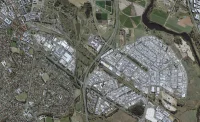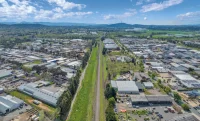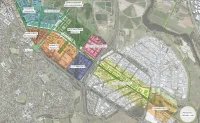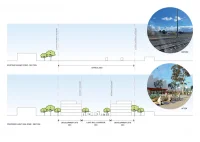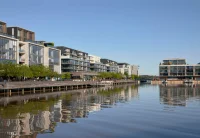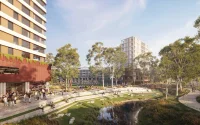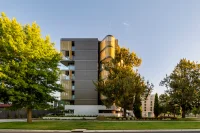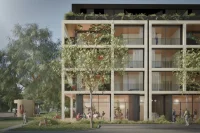East Canberra GreenlineGaining Traction
The Greenline introduces a transformative concept to reshape east Canberra through a public and active transport superhighway. If realised, it would mark a pivotal step forward, addressing urban sprawl and cultivating a resilient, interconnected city.
The Greenline introduces a transformative concept to reshape east Canberra through a public and active transport superhighway. If realised, it would mark a pivotal step forward, addressing urban sprawl and cultivating a resilient, interconnected city.
Location
Canberra
State
ACT
Country
Ngunnawal
Client
Fyshwick Business Association
Expertise
Urban Design
Year
2022
1/6
Aerial View of Present-day Fyshwick
Brief
The core of this idea lies in repurposing Canberra's underutilised heavy rail corridor into a car-free transit corridor. The proposal explores relocating the existing Kingston Railway Station to a new transport hub on Fyshwick's outskirts, freeing a 4km stretch of land primed for transformation into a linear village and active transport artery.
This proposal aims to connect east Canberra, unlocking development land and potential for inner city revitalization, accommodating Canberra’s growth while fostering a compact, yet generous urban landscape.
The core of this idea lies in repurposing Canberra's underutilised heavy rail corridor into a car-free transit corridor. The proposal explores relocating the existing Kingston Railway Station to a new transport hub on Fyshwick's outskirts, freeing a 4km stretch of land primed for transformation into a linear village and active transport artery.
This proposal aims to connect east Canberra, unlocking development land and potential for inner city revitalization, accommodating Canberra’s growth while fostering a compact, yet generous urban landscape.
Design
A linear park and transport corridor that links established and emerging precincts, including Kingston Foreshore, Fyshwick Markets, Jerrabomberra Wetlands, East Lake, Dairy Road Precinct, CIT, and Fyshwick. Situated within an existing rail corridor, this light rail and active transport pathway is car-free, supports climate resilience, and creates an opportunity for controlled urban growth.
The Greenline integrates light rail with a spacious pedestrian and cycling path, designed to encourage active transportation. Adjacent mixed-use developments frame and define the Greenline, creating secure, green spaces for the community. Beyond its transport function, the Greenline serves as an ecological corridor, cooling the urban environment and fostering a connection to the land through daily movement. Repurposing the existing rail corridor would be economical and minimise disruption within already congested roadways such as Canberra Avenue.
A linear park and transport corridor that links established and emerging precincts, including Kingston Foreshore, Fyshwick Markets, Jerrabomberra Wetlands, East Lake, Dairy Road Precinct, CIT, and Fyshwick. Situated within an existing rail corridor, this light rail and active transport pathway is car-free, supports climate resilience, and creates an opportunity for controlled urban growth.
The Greenline integrates light rail with a spacious pedestrian and cycling path, designed to encourage active transportation. Adjacent mixed-use developments frame and define the Greenline, creating secure, green spaces for the community. Beyond its transport function, the Greenline serves as an ecological corridor, cooling the urban environment and fostering a connection to the land through daily movement. Repurposing the existing rail corridor would be economical and minimise disruption within already congested roadways such as Canberra Avenue.
Impact
The East Canberra Greenline rethinks Canberra’s growth and creates infrastructure projects which help solve our growth and climate crisis. The concept has potential to form part of an eastern loop connecting the airport, city and parliamentary triangle, re-defining eastern Canberra and positioning Canberra at the forefront of resilient city-making.
The proposal has received widespread attention from the local community, government, and private industry.
The fundamental challenge of this century is to make our cities more sustainable and healthy places to live. This means creating car-free green streets that have outstanding public transport, encourage active travel and foreground wellbeing for all people. Canberra is uniquely placed to deliver this vision. - Felicity Stewart, Director, Stewart Architecture.
This proposal looks to unlock a significant quantum of underutilised land in central Canberra. Smart infill will help to limit urban development at the fringes of our already sprawling capital city. This project alone could accommodate a significant portion of Canberra’s future growth whilst safeguarding and enhancing key natural assets like the Jerrabomberra Wetlands. - Marcus Graham, Practice Principal, Stewart Architecture.
It ticks a lot of boxes in terms of infill, green space, active transport. - David Pocock, Independent Senator for the ACT (November, 2022).
The East Canberra Greenline rethinks Canberra’s growth and creates infrastructure projects which help solve our growth and climate crisis. The concept has potential to form part of an eastern loop connecting the airport, city and parliamentary triangle, re-defining eastern Canberra and positioning Canberra at the forefront of resilient city-making.
The proposal has received widespread attention from the local community, government, and private industry.
The fundamental challenge of this century is to make our cities more sustainable and healthy places to live. This means creating car-free green streets that have outstanding public transport, encourage active travel and foreground wellbeing for all people. Canberra is uniquely placed to deliver this vision. - Felicity Stewart, Director, Stewart Architecture.
This proposal looks to unlock a significant quantum of underutilised land in central Canberra. Smart infill will help to limit urban development at the fringes of our already sprawling capital city. This project alone could accommodate a significant portion of Canberra’s future growth whilst safeguarding and enhancing key natural assets like the Jerrabomberra Wetlands. - Marcus Graham, Practice Principal, Stewart Architecture.
It ticks a lot of boxes in terms of infill, green space, active transport. - David Pocock, Independent Senator for the ACT (November, 2022).
